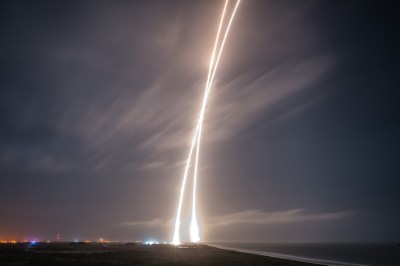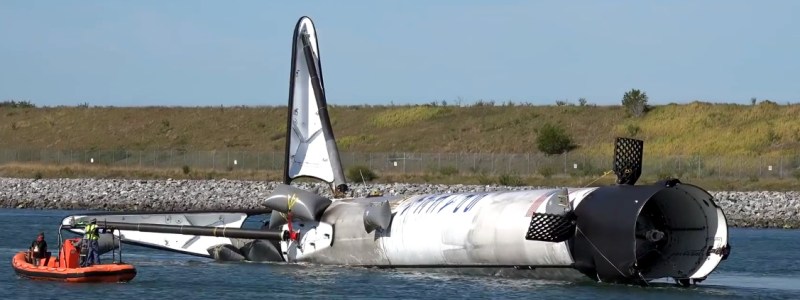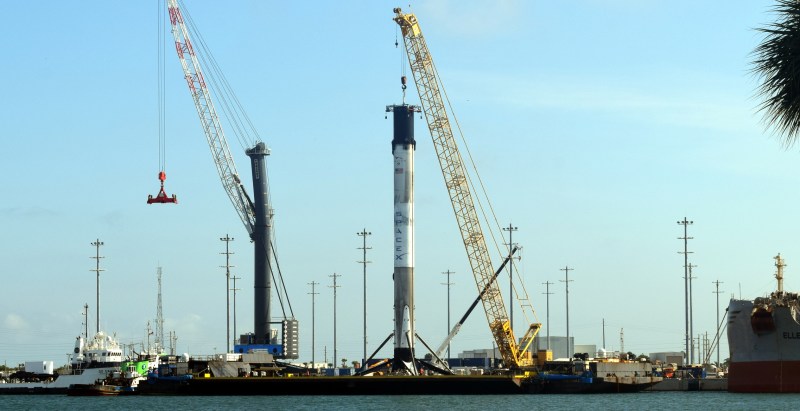With the notable exception of the Space Shuttle, rockets and spacecraft have always been considered disposable. It’s a slow and expensive way to travel, akin to building a new airliner for every flight, but it was the easiest option. These vehicles have always represented the pinnacle of engineering and material science of their time, and just surviving the trip to space once was an incredible accomplishment. To have another go around would have been asking too much of the technology. Even looking back on the Space Shuttle program, there’s plenty of debate about whether or not the reusable design really paid off in the end.
So SpaceX’s ability to land, refurbish, and refly the first stage of their Falcon 9 booster is no small accomplishment. After demonstrating the idea was possible in 2017, the company made numerous changes to the latest iteration of the rocket with reusability in mind. Known as Block 5, this version of the Falcon 9 is designed to be more survivable and require minimal servicing between flights. The company says its cheaper and faster to reuse the Block 5 than it would be to build a new one for each flight, allowing the company to approach spaceflight more like commercial aviation.

With a fleet of Block 5 boosters now in rotation, SpaceX has given them serial numbers not unlike an airplane’s tail number. It might not be the kind of thing the general public would normally be aware of, but these serial numbers have allowed a dedicated community of space aficionados to keep track of the missions each booster has flown.
Unfortunately the story of one of these rockets, officially referred to as “Cores” in SpaceX parlance, was recently cut short. Core B1056, returning from the Starlink 4 mission on February 17th, failed to land on the autonomous spaceport drone ship (ASDS) Of Course I Still Love You and splashed down in the ocean. It’s still unclear what condition the booster was in after its soft landing in the water, but when the recovery ships returned to port empty handed, there was no question as to the fate of B1056.
From a purely business standpoint, the failure of any of SpaceX’s boosters means lost time and revenue. But in some ways B1056 had established itself as the vanguard of the fleet, managing to either set or break a number of records in its relatively short life. The destruction of the most thoroughly flight proven Block 5 booster is a stark reminder that there’s very little about spaceflight that could be called routine.
A Booster of Some Note
When talking about records set by reusable booster rockets, there’s admittedly not a whole lot in the way of competition. That should change in the next couple of years as more “New Space” companies bring their reusable vehicles online, but for the time being, SpaceX is essentially running a race against themselves. Still, it’s interesting to how B1056 stacked up against its peers.
For one thing, it has the dubious honor of being the first reused Block 5 booster to be unintentionally destroyed. Although this wasn’t the first botched landing: core B1050 went into the water when it suffered a control failure as it coasted back to Cape Canaveral and had to be towed into port. A few previous cores have been allowed to crash into the ocean when a landing was deemed impractical, and core B1046 was sacrificed for Crew Dragon’s dramatic in-flight abort test.

On a more positive note, B1056 currently holds the record for having the fastest turnaround from landing to reflight of any Falcon 9 at precisely two months. This is only a few days longer than the quickest turn around in the Space Shuttle’s history, and it’s expected the process will only get faster from here. In the past SpaceX has claimed they’re targeting a 24 hour turnaround time for the Block 5, though many believe two weeks is a more reasonable goal.
Core B1056 was also the first Block 5 booster to launch two Commercial Resupply Service (CRS) missions to the International Space Station. The booster made its debut on the CRS-17 mission and then went on to launch CRS-18 a few months later. NASA allowing SpaceX to use previously flown boosters on critical ISS resupply missions is a huge milestone, showing the storied aerospace agency recognizes reuse of the Falcon 9 has transitioned from experiment to operational capability.
The Shape of Things To Come
Of course, all of those accomplishments are little more than numbers on a page for those of us who observe from the outside. Even the most dedicated of SpaceX followers wouldn’t feel any special kinship to a particular core just because it flew more missions to the ISS than its peers, or was the fastest (so far) to make it through its post-flight inspections. But in this particular case, the Hackaday community can claim a slightly better than average familiarity with a reusable rocket.
 The CRS-17 mission on May 4th, 2019 wasn’t just B1056’s first flight; it was also the first time that Hackaday was on hand to document a rocket launch. Not that we planned it that way. The fact that we were in the right time and place to see not only the pre-dawn liftoff of the booster but its triumphant return to Port Canaveral the next morning was a complete coincidence. It was awe-inspiring to see in person, and judging by the response we received to the article and video, it had a similar effect even when experienced second-hand.
The CRS-17 mission on May 4th, 2019 wasn’t just B1056’s first flight; it was also the first time that Hackaday was on hand to document a rocket launch. Not that we planned it that way. The fact that we were in the right time and place to see not only the pre-dawn liftoff of the booster but its triumphant return to Port Canaveral the next morning was a complete coincidence. It was awe-inspiring to see in person, and judging by the response we received to the article and video, it had a similar effect even when experienced second-hand.
The regular Hackaday reader has undoubtedly noticed a gradual widening of our scope over the years. While hardware hacking and engineering will always be the core of this community, it’s impossible to ignore some of the overlapping interests many of us share. In 2019 several of our highest viewed articles were about rocketry and space exploration, and why shouldn’t they be? It’s difficult to imagine an example of engineering more extreme than using a violent chemical reaction to hurtle a sensor-laden robot hundreds of millions of kilometers through space.
After describing the first launch and landing of core B1056, I ended the previous article with my belief that what I’d just seen represented a glimpse into the future. Despite the loss of that very same vehicle less than a year later, that feeling of enthusiasm is still palpable. The dream of making space more accessible to humanity is not wrapped up in a single rocket or mission. It’s an idea that engineers have been chasing since the dawn of the Space Age, and they’re far too close to give up now.
















Interesting issue of focus vs interest. One of the things I really like about HAD is that they have had a great focus but I admit I do love rockets. I watch a lot of the launches right from my office in Palm Bay Florida. Maybe some tag or subject for Space and other none project subjects. I just do not want HAD to become the mess that Slashdot became.
I also do not want that ;-)
Slashdot back in the day. “Let’s not become the mess that Wired Magazine became” :-D
Wired back in the day: “Let’s not become the mess that Byte Magazine became”
But isn’t that the trick? HAD can not be everything to everyone and do it well. Just how big of a scope do you want for HAD? To be honest I think you do a good job on scope. I found HAD because of Slashdot. Now I hardly go to Slashdot and tell others about HAD all the time.
THIS. Take it off the blog, make a new tab up top, Aerospace.
It costs less to re-furbish a block-5 engine than to make one new, but the cost of the entire system is more if you look at a single launch. The savings of recycling each booster come around at around 10-12 launches and the system cost is half if the boosters can be recycled 20-24 times. Of course, this is just savings on the booster – which is just one part of the launch system, so the total savings per launch is less.
Why does this matter? Because the probability of 1) random failure, or 2) needing the booster to fly to a higher orbit with a heavier load means the booster is or has to be expended before it makes the 12th launch. That makes the point of the re-usable rocket dubious, and that’s the thing that SpaceX hasn’t been able to prove so far: is it _actually_ cheaper than just making new rockets every time.
Another thing entirely is how much less reliable you get when you actually have launched the same booster 24 times. So far the most any one booster has survived is something like 5 launches, so that’s another thing that SpaceX hasn’t been able to prove – whether their boosters can be refurbished repeatedly up to the point of break-even.
But of course, since this is Elon Musk, everyone just takes his word on it on wishful thinking and calls it done – success! Kinda like how Obama got the peace prize simply for getting elected.
The majority of SpaceX launches in 2019/2020 are on reused B5 rockets. Are you seriously suggesting they are operating their entire business at a loss just so they can pretend a reusable rocket is cheaper?
I’m not going to comment on Lukes origonal post but I will say that is entirely possible. Elon has shown himself to be the kind of man who will just throw money at ideas for the reason of a dream. *cough hyperloop cough*. When you have millions to throw away from selling paypal it’s not unreasonable for him to be operating SpaceX at a loss. In fact I would be incredibly surprised if SpaceX has started turning a profit at this point. Will they in the future is an entirely different question one that requires serious investigation, but I will agree with Logan on the point that people are willing to suck Elons wishful thinking teet until they starve. *cough hyperloop cough*
With Elon’s tech background he probably doesn’t know how else to run a business. Operate in the red while turning focusing on publicity rather than the product, wait for a buyout offer….wait for it…. sell out and start another company.
They’re not making a loss. They’ve got a roster of launches with NASA paying way above what they claim it costs for them.
The point is that Musk is claiming the rockets are cheaper than they really are in order to keep appealing to investors, and to keep the excuse that NASA should keep throwing public money at him because he’s “making progress” with technology that isn’t really going anywhere. It’s basically a boondoggle wrapped up in technology hype.
Point being, Musk claims that he’s got the launch prices down to $60 million or whatever, but he’s actually charging NASA $120 million per launch which isn’t any cheaper than the competition. Why NASA doesn’t go to the competition is because the public loves Musk, because Musk keeps on promising the pie in the sky.
Have you even spent ten seconds looking at what a launch costs, or are you just angry at Musk because you lost a lot of money shorting Tesla?
“The (COTS) contracts include a minimum of 20 missions, 12 missions for SpaceX ($1.9 Billion) and 8 missions for Orbital Sciences ($1.6 Billion).”
https://en.m.wikipedia.org/wiki/Commercial_Orbital_Transportation_Services
It’s not hard math to see that SpaceX is cheaper than Orbital Sciences.
SpaceX charges NASA that much because it is written in the contract that they signed.
>”SpaceX charges NASA that much because it is written in the contract”
Same goes for Orbital and ULA etc. The prices depend on the contract, not the cost of the launch. That was exactly the point. What SpaceX says it costs is not what their customers are paying for it, and even those numbers you quote don’t include all the other “special deals” NASA has signed that simply throw money at them.
The numbers that they keep throwing up about the launch costs of the system are just plain fantasy. The re-usable rockets aren’t any cheaper in reality.
Besides, SpaceX is mostly funded by special awards rather than by making profits out of their launch costs. For example, the $2.6 billion that NASA awarded them to develop the Dragon 2 crewed capsule.
Their launch prices are essentially subsidized by SpaceX playing as NASA’s subsidiary development laboratory.
That 2.6b$ was awarded eons ago (regardless of whether it had been distributed incrementally or not) and I highly doubt that it even covers the entire development costs.
That contract is still on-going as far as I know. Some of it was paid up front and some will be paid on completing the six launches stipulated in the contract. That’s a heck of a price for six launches.
“The point is that Musk is claiming the rockets are cheaper than they really are in order to keep appealing to investors, and to keep the excuse that NASA should keep throwing public money at him because he’s “making progress” with technology that isn’t really going anywhere. It’s basically a boondoggle wrapped up in technology hype.”
It’s amazing to me how clearly you can see this while NASA and the investors can’t. If only they would read your comments, or maybe read SpaceX’s annual report
NASA sees more value in having someone they can throw under the bus next time astronauts get killed.
Of course NASA sees it. Do you not understand what a boondoggle is?
As long as the public thinks highly of SpaceX, they’ll keep supporting the government throwing money at NASA throwing money at SpaceX, and the investors don’t care as long as SpaceX keeps paying them returns.
A technology hype? Which technology? Oh…some people probably do believe that SpaceX is a huge step forward. But, basically, it’s just rocket science. I think there is a saying that rocket science is awesome, but at core of applied rocket science, it says “you don’t have to be good, you just have to be good enough”. Ever wondered about the crude approximation for the speed of sound which NASA prints on their “rocket science” shirts and mugs? Well, it’s good enough. SpaceX did nothing spectacularly new, they just managed to lower the cost per launch a little bit and that was “good enough to beat the competition”. Oh, and marketing.
I have been told, actually, that SpaceX did consider new technology, like an aerospike engine. But that violated the “you don’t have to be good, you just have to be good enough” principle. Why bother?
Can you please site or explain the 10-12 to 20-24 launches to break even statistic?
Yes the payload is lower, however, for the majority of launches, they cannot sell the extra capacity.
There are only so many cubesats that want a specific orbit.
Additionally, with the ISS resupply missions, they cannot launch cubesats, and if NASA wanted more supplies delivered, they wouldn’t let SpaceX reuse the booster.
“a glimpse into the future”
Adding return capability to a traditional rocket is always a sacrifice on its payload capacity. The booster can lift with only 1/3rd its full energy when it has to return, and if the same is done for the second stage, then you end up with a big rocket capable of lifting 10% the mass compared to a single use rocket. The rocket equation is pretty strict on this – if you want to make the entire rocket return under its own power, the only thing it can lift into orbit is the paint on its skin.
This is not the future. This is just a gimmick; there has to be a better way.
Which is why the F9 was built to have a significantly higher payload capacity than was actually necessary for the market it serves, so it can afford to devote a chunk of it’s capacity to recovery hardware and still be profitable.
The higher launch capacity makes it more expensive to build compared to a smaller rocket built to handle the reduced mass. Over-engineering is not what makes a rocket profitable.
What other rocket are you referring to? There is no other launch vehicle even close to the cost/payload ratio of the Falcon.
That depends on whether you believe Musk on the cost. The actual price paid by SpaceX’s customers per launch is an entirely different matter.
[Citations Needed]
The Russian Proton-M (when they still were a thing) had a comparable payload to LEO as the Falcon 9 FT. and cost ~$65 Million
The Soyuz-2 can only take 18,100 lb to LEO and costs ~$80 Million
The Saturn IB (when they still were a thing) could only take 46,000 lb to LEO and cost ~$148 Million in today’s money.
The Atlas V has a configuration that can carry a similar payload to the F9 LEO and costs ~$110 Million
The Antares 230+ can only take 18,000 lb (vs 50,300 lb of the current block F9’s) and costs $80-85 Million
The Falcon 9 v1.1 took 28,990 lb to LEO and was ~$61 Million
The Falcon 9 Block 5 will take 50,300 lb to LEO (expendable vehicle) and is $62 Million
Obviously when operating in reusable mode you don’t get that full 50,300 lb to LEO, but the price is likely around $50 Million
Please for the rest of us demonstrate a launch system that takes ~50,000lbs to LEO thats cheaper than the Falcon 9.
Again, that depends on whether you believe SpaceX’s valuation of the launch system – which is up to their words. The actual price paid by customers depends on the contract, and is higher.
I’m willing to believe that the F9B5 has an actual cost comparable to the Proton-M and no less.
Not quite with you there.
If you use rocket propellant to get up, and only rocket propellant to get back, yes.
But if you use propellant to get up, then a parachute to get down to a nice height where you jettison the parachute and use propellant to slow the ‘last bit’, the equation changes. How much though, I don’t know.
But SpaceX doesn’t use a parachute.
Speaking of economically viable and profitable commercial rockets, has anyone tried just pressing or papier mache-ing a load of $20 bills together in a big, thick tube and blowing oxygen down the middle?
Same principle as this.. https://hackaday.com/2012/09/26/hybrid-rocket-engine-uses-acrylic-as-fuel/
I know you’re being sarcastic but I wouldn’t put it past the government to try, or at least throw a few hundred million at a study just to determine it’s unfeasible.
In the late 40’s the Pacific Rocket Society was launching wooden rockets like that, burning the fuselage as fuel with O2, getting interesting results. I would be surprised if they were the only ones to try it.
Oh yea, hybrid rocket, wood is a good idea but salami is tastier.
https://www.youtube.com/watch?v=i0zon3xOaI4
If you want to use paper as fuel, you can use recycled paper.
Still loving the Iain M Banks “Player of Games” reference…
Regardless of costs…. It is still cool to see part of a rocket get reused and the technology to make it so. Still not perfect obviously, but I am glad to see there are people willing to spend part of their wealth to follow there dream and put a lot of people to work to make it happen. Win Win for everyone. I think it’s great. Someday maybe we’ll see a full rocket leave and return.
Hey Elon,
Question: What do you do with old Falcon rocket boosters that you can’t fly any more?
Answer: Take them to the Nevada desert, fule them up, and detonate them.